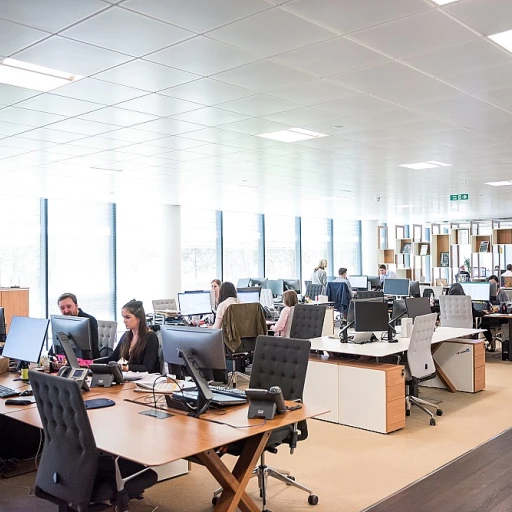
Understanding Hybrid Work Models
Exploring the Dynamics of Hybrid Work Models
The hybrid work model has emerged as a pivotal strategy for companies navigating the evolving landscape of modern business. It blends remote work with traditional office settings, offering flexibility and adaptability to employees and employers alike. This approach allows workers to split their time between home and the office, aiming to balance productivity, employee satisfaction, and operational efficiency.
Understanding the nuances of hybrid working is crucial for businesses aiming to harness its benefits while mitigating potential risks. The hybrid workforce is diverse, comprising remote employees and those who prefer or need to be in the office. This diversity requires a tailored approach to management, communication, and security.
As companies adopt this model, they must address various challenges, including ensuring health safety and managing security risks. The shift to hybrid work necessitates robust risk management strategies to safeguard both physical and digital environments. For instance, remote workers often rely on unsecured networks, increasing the risk of data breaches and unauthorized access. Similarly, employees working in the office face different health and safety concerns.
Effective communication and management practices are essential to navigate these complexities. Companies must foster a corporate culture that supports hybrid work, promoting open dialogue and collaboration across all levels of the organization. This cultural shift is vital for maintaining employee engagement and mental health, which are critical components of a successful hybrid work environment.
For more insights into how corporate culture is transforming in response to these changes, explore the rise of the virtual COO and its impact on corporate culture.
Identifying Safety Risks in Hybrid Work
Spotting Potential Dangers in Hybrid Work Settings
Hybrid work environments, where employees split their time between remote work and the office, create new dynamics and potential safety risks that companies must manage. It is essential to recognize these dangers to protect both physical and mental health and ensure a seamless transition between home and office settings. One of the significant challenges in hybrid models is managing security risks. Remote working can expose businesses to data breaches, unauthorized access, and unsecured network issues. With employees frequently working from various locations, the chances of cyber threats, such as phishing attacks, increase. Companies need to have robust security measures in place to protect sensitive data and the devices employees use to access it. From the physical side, maintaining safety in a hybrid workplace can be complex. Many employees are juggling different environments, each with its own health and safety concerns. At home, risks might include ergonomic issues or inadequate workspace setup, while in the office, shared spaces and resources can pose health safety risks. Another significant concern is the mental health of the hybrid workforce. Balancing the demands of a hybrid work model can lead to stress and burnout, particularly when clear communication and support from management are lacking. It's crucial for companies to foster open communication channels to help employees feel connected and supported regardless of their working location. Read more on how corporate culture plays a role in navigating these hybrid work challenges and fostering a safe working environment: The Rise of the Virtual COO: Transforming Corporate Culture.Cybersecurity Challenges in Hybrid Work
Addressing the Digital Risks in a Blended Work Environment
In the realm of hybrid work models, cybersecurity stands out as a prominent concern. With the workforce now distributed more than ever between homes and offices, companies face an increased risk of data breaches and unauthorized access. Cybersecurity is not merely an IT issue; it’s integral to the overall health and safety of a business. Remote employees often work over unsecured networks, which can expose sensitive business data to cyber threats. The use of personal devices further complicates the landscape, as these devices might lack adequate security measures. This increases exposure to phishing attacks, malware, and other cybersecurity risks. The issue becomes more complex considering the dual workspace nature of hybrid working. Companies must ensure that remote workers and those in the office are equally protected. Employers need to prioritize robust communication strategies to educate employees about potential risks and preventative measures. Risk management plays a crucial role here. Ensuring that employees working in a hybrid model have clear guidelines about data security and privacy can mitigate many risks associated with remote working. Businesses need to invest in secure systems that can adapt to various work environments, providing a seamless and safe experience for all workers. In light of these complexities, enhancing security doesn’t only mean investing in technology. Corporate culture plays a significant role in protecting the workforce. Companies must foster a culture that prioritizes cybersecurity as part of mental health and safety initiatives, embedding these values into the everyday actions of employees. For more insights on how corporate culture can address these challenges, explore the digital risks and corporate culture.Physical Safety in a Hybrid Workplace
Addressing Unique Physical Safety Challenges
In hybrid work environments, physical safety takes on new dimensions. As employees are scattered between home offices and corporate spaces, companies must reassess traditional health and safety protocols. The hybrid model necessitates consideration of both remote working conditions and office-based activities, which together form a comprehensive approach to health safety management. For remote workers, it is crucial to recognize risks such as ergonomic hazards, which may arise from prolonged use of non-standard or makeshift office setups. Companies should offer guidance on optimal desk and chair setups to mitigate the risk of musculoskeletal issues. Communication is vital for employees working in-office as well. Clear directives regarding safety procedures, emergency responses, and equipment handling should be disseminated effectively across the workforce. This ensures all employees understand their role in maintaining a safe hybrid workplace. Management must also be vigilant about security risks stemming from authorized and unauthorized access to office premises. Security measures, like controlled access points and surveillance, can effectively monitor and mitigate these risks. Finally, mental health is an important facet of physical safety often overlooked. Hybrid working can blur boundaries between work and personal life, leading to stress or burnout. Companies could benefit from providing mental health support services to help employees manage their well-being while balancing remote and office work demands.Strategies for Mitigating Hybrid Work Safety Risks
Implementing Effective Risk Management Practices
As businesses transition to hybrid work models, creating a comprehensive risk management strategy becomes crucial. Hybrid working introduces a range of risks that require proactive safety measures. Companies must ensure that risk management practices are robust enough to address both physical and cybersecurity challenges associated with remote and office work environments.
One primary approach is fostering a culture of open communication to ensure all employees are aware of potential risks and understand the importance of adhering to safety protocols. Regular training sessions can educate the workforce about identifying and responding to cyber threats like phishing attacks and data breaches.
- Ensure secure access: Protect data and prevent unauthorized access by implementing strong authentication protocols for both in-office and remote employees.
- Regular updates: Keep company devices and software up to date to guard against vulnerabilities that could be exploited by cyber threats.
- Promote a safe physical workspace: Both remote workers and office employees should have access to ergonomic resources and health safety guidelines to prevent mental health and physical health issues.
Additionally, companies should establish health services that offer support to employees working remotely and those in office settings. This can enhance the overall well-being of the hybrid workforce and reduce health-related risks significantly. Businesses that implement these strategies effectively align with the goals of ensuring safety, security, and productivity in a hybrid work environment.













